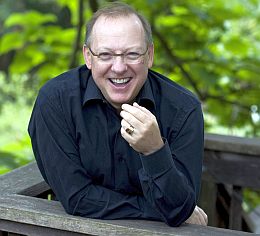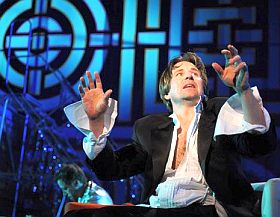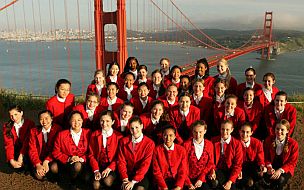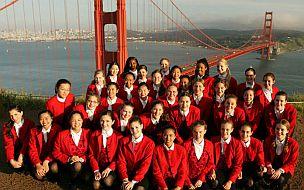It was almost as if Herbst Theatre itself were smiling in delight Thursday as Nicholas McGegan and his Philharmonia Baroque Orchestra played a memorial tribute to Felix Mendelssohn’s bicentennial. The audience seemed even more delighted. Glancing up and down my aisle, I noted that every face had a broad expression of pure pleasure. In toto, the concert turned out to be one of the ultimate feel-good events of the season.

McGegan opened with the somber “Hebrides” Overture, Op. 26, followed by Mendelssohn’s reorchestrated version of the scherzo from his String Octet, Op. 20, plus the Three Motets, Op. 39. The latter included lovely vocalism by the San Francisco Girls Chorus.
After intermission came the feast: the full incidental music for Shakespeare’s Midsummer Night’s Dream, Opp. 21 and 61. Besides the orchestra and Girls Chorus, that performance included fairly generous hunks of the Bard’s text, chosen to precede the music written for it. For that, McGegan had the services of actor Stephen Barker Turner.

Stephen Barker Turner in
California Shakespeare Theater's
Twelfth Night
In a normal performance with a modern symphony orchestra, the “Hebrides” Overture — or Fingal’s Cave, if you prefer — tends to sound like midnight gloom. With a large orchestra, it can sound downright murky. But with the smaller orchestra of PBO, those problems vanished. All was clear and bright. With McGegan’s smaller forces, the sun shone out through the piece. Many details came floating up to the surface in Mendelssohn’s quasi–tone-poem of surf and cliffs.
Of course, Philharmonia Baroque is the size of orchestra that Mendelssohn wrote for. When he arrived to his Leipzig Gewandhaus post, for instance, his orchestra consisted of 35 musicians. (With time he expanded that to 45.) That was about the average size for symphony orchestras in major cities. It was Berlioz and Wagner who started busting stages at the seams by requiring a hundred or more musicians.
The exceptions were the occasional massive choral festivals. For those, humongous forces were arrayed. You come across things like an orchestra with 44 oboes, with similar exaggeration throughout the orchestra. Those turned up to support a chorus of many hundreds of singers. Haydn’s oratorio The Creation was a frequent victim of such bloating during the 19th century.
The principal reason for Mendelssohn’s expanding his Octet scherzo, notably by adding the winds, was that it might serve as an alternative to the original Menuetto in his First Symphony. That has always struck me as a bit odd, since that Menuetto is in quick tempo — Allegro molto. Still, the performance of that revamped scherzo proved wonderfully apt, especially with McGegan’s tempo selection and care for the proper dynamic levels.
Sisters Inspire
Then came the three Latin Motets, written in Rome. They were partly inspired by the nuns singing next door to the composer’s lodgings. McGegan orchestrated the original organ part for his orchestra, to better fit the occasion. Good job. While it did not sound especially like Mendelssohn, it was quite effective on its own terms.

All three Motets together last only about 20 minutes, using a kind of double chorus. We heard a set of six-soloists chamber choir contrasting with the full chorus. The Girls Chorus displayed a lilting variety of sound via memorably melodic writing, as well as seriously accomplished solo singing. I must mention soprano Sian Wittke as being especially impressive. My one complaint would be the rather so-so elocution of the Latin text.
The largest, most rewarding surprise of the evening was saved for last. What I’d seen announced was simply the Overture to A Midsummer Night’s Dream. But lo and behold, we got the full score … or anyway, 11 of the original 13 sections. The two missing movements are too scant for concert use; they contain only scrap motives lasting a few seconds, used during full theatrical productions of the play to highlight bits of dialogue.
The performance was excellent in every respect, the Girls Chorus singing the Fairy Choruses ravishingly. Those were highlights, featuring fine solo work by soprano Wittke as the First Fairy and alto Emma Dowd as the Second Fairy. (”Come not near our fairy queen. Hence away!” goes their lullaby to the sleeping Queen Titania.) There was absolute magic in that.
Narrator Turner is an experienced pro with a good deal of experience on stage, in film, and in television. He’s performed Shakespearean plays with A.C.T., the California Shakespeare Theater, the New York Shakespeare Festival, and other organizations.
Master Actor
While reading excerpts from the play, he took on several different roles, all very well indeed. The breadth of his mastery impressed the devil out of me. His reading of the prologue and the epilogue were emotionally quite touching. Yet he saved his big guns for the outlandish, incompetent Bottom’s prologue to the play within the play.
The speech is a comic masterpiece, to begin with, as much a historical prologue to the theater of the absurd as it is to Pyramus and Thisbe. Here, any exaggeration is not only acceptable but necessary. Turner did a super job of camping it up: bellowing, prancing about a bit, leaning over toward the audience. He even had the chorus and orchestra tittering.
I was sort of hoping for a musical encore. Say, the Fairy lullaby? But it had been a long program. After Turner lovingly delivered Puck’s closing epilogue — “So goodnight unto you all. Give me your hands, if we be friends, and Robin shall restore amends” — I guess that more performing would have seemed like sacrilege, other than for the ovation that followed, as the friendly audience indeed gave the artists their hands.

